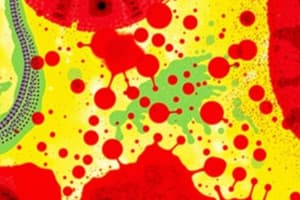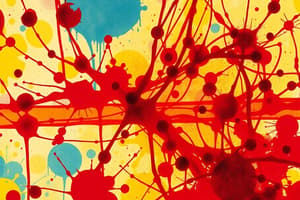Podcast
Questions and Answers
What is a characteristic feature of arterial blood stains?
What is a characteristic feature of arterial blood stains?
- They create jets or sprays. (correct)
- They form pear shapes indicating direction.
- They appear in circular shapes.
- They consist of dull brown stains.
Which condition can delay the clotting process of blood?
Which condition can delay the clotting process of blood?
- Warfarin toxicity. (correct)
- Hypothermia.
- Presence of excessive fibrinogen.
- Chronic dehydration.
What does a fresh blood stain primarily contain that affects its solubility in distilled water?
What does a fresh blood stain primarily contain that affects its solubility in distilled water?
- Fibrin.
- Oxyhemoglobin. (correct)
- Hematoporphyrin.
- Methemoglobin.
What is the expected appearance of a blood stain that is 1-2 days old?
What is the expected appearance of a blood stain that is 1-2 days old?
Which of the following tests is not a good negative test for the presence of blood?
Which of the following tests is not a good negative test for the presence of blood?
What characteristic shape indicates blood dropped vertically onto a surface?
What characteristic shape indicates blood dropped vertically onto a surface?
Which species identification method can be used after confirming the sample as blood?
Which species identification method can be used after confirming the sample as blood?
What does the presence of oxidase enzyme in blood help to detect?
What does the presence of oxidase enzyme in blood help to detect?
What distinctive feature do basophilic fragments in RBCs present as in a blood film?
What distinctive feature do basophilic fragments in RBCs present as in a blood film?
Which of the following is a primary advantage of spectroscopic examination of bloodstains?
Which of the following is a primary advantage of spectroscopic examination of bloodstains?
What absorption characteristic helps differentiate carboxy Hb from oxy Hb during spectroscopic examination?
What absorption characteristic helps differentiate carboxy Hb from oxy Hb during spectroscopic examination?
What results from the addition of an oxidizing agent during the spectroscopic examination?
What results from the addition of an oxidizing agent during the spectroscopic examination?
Which method can produce reduced Hb from a blood stain?
Which method can produce reduced Hb from a blood stain?
What is a result of utilizing a precipitin test in serological examination?
What is a result of utilizing a precipitin test in serological examination?
Which of the following is NOT a characteristic absorption for Met Hb?
Which of the following is NOT a characteristic absorption for Met Hb?
Which absorption pattern is associated with hemochromogen?
Which absorption pattern is associated with hemochromogen?
What color and shape are the crystals formed in Teischmann's test?
What color and shape are the crystals formed in Teischmann's test?
What type of RBC shape is characteristic of non-mammalian species?
What type of RBC shape is characteristic of non-mammalian species?
In Takayama's test, what color are the haemochromogen crystals formed?
In Takayama's test, what color are the haemochromogen crystals formed?
What is the primary purpose of microscopical examination of bloodstains?
What is the primary purpose of microscopical examination of bloodstains?
What is the characteristic diameter of RBCs from a horse?
What is the characteristic diameter of RBCs from a horse?
What distinguishes female neutrophils in terms of identifying sex in blood examination?
What distinguishes female neutrophils in terms of identifying sex in blood examination?
Which of the following tests is considered confirmatory for identifying the presence of blood?
Which of the following tests is considered confirmatory for identifying the presence of blood?
What enzyme associated with lead toxicity inhibits the removal of nuclear remnants in RBCs?
What enzyme associated with lead toxicity inhibits the removal of nuclear remnants in RBCs?
Flashcards
Spectroscopic Examination of Bloodstain
Spectroscopic Examination of Bloodstain
A confirmatory test for blood, using a spectrometer to analyze its absorption bands. It can detect different types of hemoglobin.
Oxyhemoglobin (Oxy Hb)
Oxyhemoglobin (Oxy Hb)
Hemoglobin bound to oxygen, showing two dark bands between D and E spectral lines.
Carboxyhemoglobin
Carboxyhemoglobin
Hemoglobin bound to carbon monoxide, showing bands similar to oxyhemoglobin but shifted slightly to the right.
Reduced Hemoglobin
Reduced Hemoglobin
Signup and view all the flashcards
Methhemoglobin (Met Hb)
Methhemoglobin (Met Hb)
Signup and view all the flashcards
Hemochromogen
Hemochromogen
Signup and view all the flashcards
Precipitin test
Precipitin test
Signup and view all the flashcards
Serological examination
Serological examination
Signup and view all the flashcards
Bloodstain color change
Bloodstain color change
Signup and view all the flashcards
Blood Clotting
Blood Clotting
Signup and view all the flashcards
Bloodstain Dryness
Bloodstain Dryness
Signup and view all the flashcards
Blood Solubility
Blood Solubility
Signup and view all the flashcards
Bloodstain Shape - Arterial
Bloodstain Shape - Arterial
Signup and view all the flashcards
Bloodstain Shape - Drop
Bloodstain Shape - Drop
Signup and view all the flashcards
Preliminary Blood Tests - Protein
Preliminary Blood Tests - Protein
Signup and view all the flashcards
Preliminary Blood Tests - Enzyme
Preliminary Blood Tests - Enzyme
Signup and view all the flashcards
Teischmann's test
Teischmann's test
Signup and view all the flashcards
Takayama's test
Takayama's test
Signup and view all the flashcards
Mammalian RBCs
Mammalian RBCs
Signup and view all the flashcards
Non-mammalian RBCs
Non-mammalian RBCs
Signup and view all the flashcards
Bloodstain species identification
Bloodstain species identification
Signup and view all the flashcards
RBC Diameter
RBC Diameter
Signup and view all the flashcards
Davidson body
Davidson body
Signup and view all the flashcards
Lead toxicity
Lead toxicity
Signup and view all the flashcards
Study Notes
Examination of Bloodstains
- Examination of bloodstains involves several steps, including physical, chemical, and serological examinations
- Physical examination focuses on aspects like color, which changes based on age and source
- Fresh blood stains are bright red
- 1-2 days old stains are reddish-brown
- 2-3 days old stains are dull brown
- Blood on leather immediately turns brown due to formation of metHb
- Blood on glass remains red for several months
- Clotting usually occurs within 2-10 minutes of blood shedding, transforming soluble fibrinogen into insoluble fibrin
- Blood from a dead body is partially coagulated because plasma lacks fibrinogen, gradually changing into fibrin
- Clotting can be delayed due to factors like hemophilia, warfarin toxicity, and asphyxia
- Dryness depends on atmospheric conditions
- Fresh blood stains are wet and may take 20-30 minutes to dry in Egypt's conditions
Solubility
- Fresh blood stains contain oxyHb, which dissolves in distilled water or normal saline
- Older stains contain metHb or hematin, dissolving in diluted acid or alkali
- Very old stains have hematoporphyrin, which dissolves in strong acid or alkali
- Blood in burns requires 5% HCl for dissolving
Shape
- Arterial blood stains are in jets or sprays
- Circular stains form if blood drops vertically onto a surface
- Pear-shaped stains indicate a wounded, moving person; the narrower end points towards the direction of movement
Preliminary (Macrochemical) Tests
- Good negative tests confirm if a substance is not blood
- These tests rely on the presence of protein and oxidase enzymes in blood
- The stain is prepared as a clear solution (if turbid, filtered)
- Tests for protein, ammonia, and foam (Ganttner's)
Tests based on oxidase enzyme
- Oxidases are also found in vegetable stains
- These tests (Guaiacum, Benzidine, Phenol phtalein, Kastle-Meyer's, O-Tolidine, Leucomalachite Green tests) only produce good negative results
Confirmatory Chemical Tests (Micro-chemical)
- These tests rely on the presence of hemoglobin in dried blood
- Teischmann's test (Haemin crystals) and Takayama's test (Haemochromogen crystals)
- Reagents include NaCl (1 gm), NaBr (1 gm), NaI (1 gm), and acetic acid (100cc)
- Crystals are brown and rhombic
- Reaction is acidic
- Crystals often appear single or in groups, forming "Chinese lettering"
Takayama's Test (Haemochromogen Crystals)
- Reagents include NaOH (1 part), pyridine (1 part), saturated glucose solution (1 part), and distilled water (7 parts)
- Crystals are pink and spindle-shaped
- Reaction is alkaline
- Crystals appear in groups, forming feather or rosette-like patterns
Microscopical Examination
- Confirmatory tests for bloodstains based on blood cells
- Used primarily for fresh blood samples
- Samples are stained with Leishman or Giemsa stains
Species Determination (Blood Cells)
- Mammalian blood cells (excluding camels) are circular, biconcave, and non-nucleated
- Camel blood cells are oval, biconvex, and non-nucleated
- Other non-mammalian blood cells (e.g., birds, reptiles) are oval, biconvex, and nucleated
Blood Cell Diameters
- Sheep/goat RBCs: 5.5 microns
- Horse/cat/ox/pig RBCs: 6 microns
- Human/rabbit/dog RBCs: 6.5 microns
- Elephant RBCs: 9.5 microns
Sex Determination (Neutrophils)
- About 3% of female neutrophils contain a Barr body (drumstick), a small nuclear mass attached to the nucleus by a thin filament
Toxicity (Lead)
- Lead toxicity interferes with pyrimidine-5-nucleotidase enzyme action
- Resultant RBCs show basophilic fragments or stippling in the blood film
Spectroscopic Examination
- Spectroscopic method verifies hemoglobin or its derivatives within stains
- Technique involves adjusting apparatus for distinct Fraunhofer lines; stain fluid is interposed between apparatus source.
- OxyHb exhibits two dark bands between lines D and E
- CarboxyHb displays bands similar to oxyHb but shifted to the right
- ReducedHb shows a single, broad, badly defined band between lines D and E
- MetHb displays four bands—one close to D-line, a second near E-line, two more in the C/D area and E/F area
Serological Examination (Precipitin Test)
- Injecting a specific protein (serum) into an animal creates antibodies within the animal's blood
- Antibodies react specifically with injected substance upon contact
Precipitin Test (Details)
- Rabbits or fowl are injected with human blood every 3rd day for 3-5 times
- Once killed, the animal's anti-serum is collected
- A suitable antiserum should react with the substance immediately at 1/1000 dilution
Blood Grouping
- Blood grouping helps determine if a bloodstain originated from a particular individual
Studying That Suits You
Use AI to generate personalized quizzes and flashcards to suit your learning preferences.



